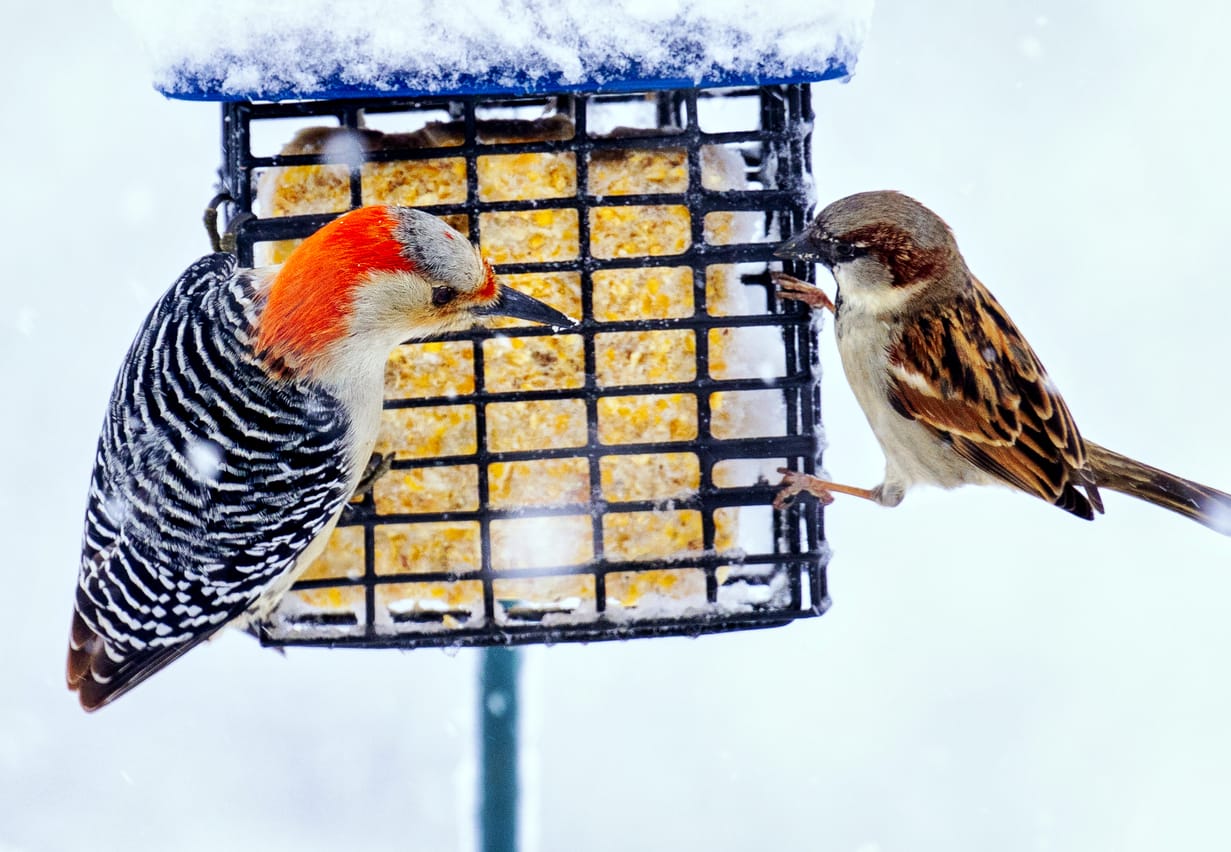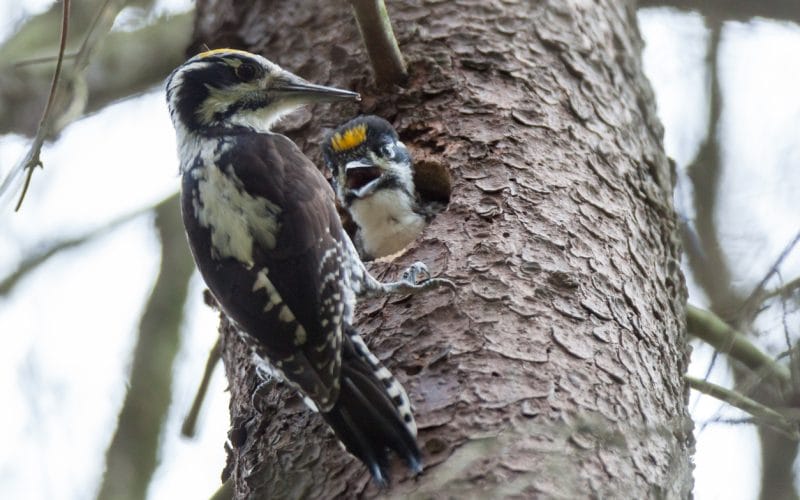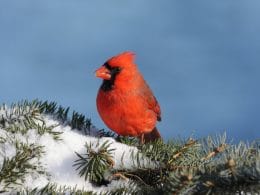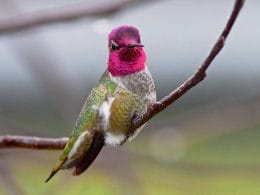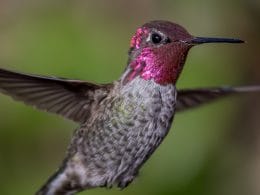Did you know that woodpeckers can peck up to 20 times in one second? The speed of how they move their heads sometimes exceeds 15 miles an hour!
That drumming often sets woodpeckers apart from most other birds, which is why they’re often sought, photographed, and videoed.
If you’re among the woodpecker enthusiasts and live in Minnesota, then you would love to know more about woodpeckers in Minnesota.
Those are the eight woodpeckers that you could find in the state if you know where and how to look (or listen!)
1. Downy Woodpecker
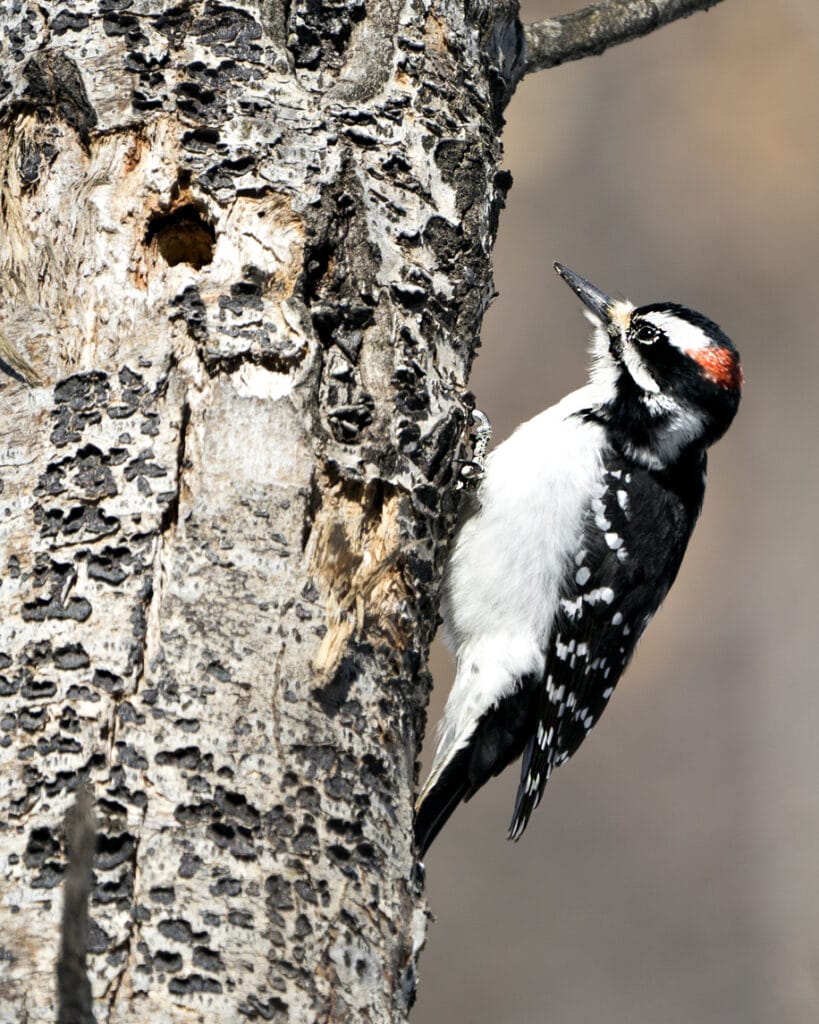
- Scientific name: Dryobates Pubescens
- Length: 5.5-6.7 inches
- Weight: 0.7-1.0 ounces
- Wingspan: 9.8-11.8 inches
Downy Woodpecker is the smallest bird on our list but it’s one of the most common sights in the United States.
The small-sized woodpeckers are so small that they weigh less than an ounce! They are also smaller than most robins.
Author Note: Downy Woodpeckers use that small size to their advantage. They often forage in places where most other woodpeckers (and birds) can’t reach.
Description wise, Downy Woodpeckers have a beautiful black and white pattern on their wings and crowns. There’s a red patch on the back of the head which is present only in the male. The rest of the bird is white for the most part.
Downy Woodpeckers are bark foragers. If you happen to spot some of them, they’d often be hanging on the barks of trees looking for food. They rely mainly on small insects like ants.
In Minnesota, Downy Woodpeckers are a common sight wherever trees are found. That includes your backyard too, especially if it has some bird feeders.
Because of their small size, Downy Woodpeckers often join flocks of other birds for protection. They prefer to mix with birds that have the same size like chickadees.
Downy Woodpeckers have a delightful call that’s made of quick chirps. They often follow their calls with short and light drumming.
They’re not the fastest woodpeckers out there and their small size doesn’t allow them to peck hard, so they\ll never be too noisy for you.
2. Hairy Woodpecker

- Scientific name: Dryobates Villosus
- Length: 7.1-10.2 inches
- Weight: 1.4-3.4 ounces
- Wingspan: 13.0-16.1 inches
Hairy Woodpeckers are essentially Downy Woodpeckers that have been hitting the gym! Their body size is almost 40% larger and they have triple the weight of Downy Woodpeckers.
Hairy Woodpeckers can be seen all year in Minnesota just like their smaller peers. However, because of their relatively larger size, they’re not as commonly found.
Hairy Woodpeckers prefer larger trees and as a result, they’re less found in urban areas and parks. You can still spot some of them in larger forests, though.
The color pattern of Hairy Woodpeckers is almost identical to that of Downy Woodpeckers. Males of Hairy Woodpeckers have the same identifying red patch on the back of their heads as well.
Habitat and color patterns aren’t the only similarities between Hairy and Downy Woodpeckers, their calling and drumming are more or less the same as well. The difference is that Hairy Woodpeckers are louder and drum harder because of their size.
So, how will you be able to differentiate between the two of them? Size alone isn’t enough from a distance. It can be tricky, but there are some hidden identifying features.
Besides the size, Hairy Woodpeckers have longer and sharper bills than Downy Woodpeckers. Their backs are also a bit more straight which gives the appearance of a soldier. They have been hitting the gym after all.
It will take some time and practice before you could instantly tell the difference between both of them, but you’ll get there.
3. Black-backed Woodpecker

- Scientific name: Picoides Arcticus
- Length: 8.9-9.1 inches
- Weight: 2.1-3.1 ounces
- Wingspan: 15.8-16.5 inches
Black-backed Woodpeckers are almost the same size as Hairy Woodpeckers, but they’re nowhere near as common in the United States as them. Black-backed Woodpeckers mostly inhibit Canada as they prefer the cooler weather.
In Minnesota, however, they can be found all year long, especially in the northern parts which are close to the Canadian border.
Black-backed Woodpeckers are black for the most part. They have white patches on their wings and the belly is often white. The crown is black with two white lines near the bill that look like a mustache.
Top Tip: You can tell the males from females by the yellow patch on the forehead of males. Keep in mind that juvenile Black-backed Woodpeckers of both genders have this yellow patch. It just disappears in females when they reach adulthood.
Black-backed Woodpeckers blend so well with darker or “burned” trees. That’s why they have a preference for forests that got burned recently.
Their plumage offers them camouflage against predators. That allows them to freely hunt for the wood-boring beetles. Black-backed Woodpeckers would drill some test holes to find the tunnels where beetles live.
The woodpeckers would then insert their long tongues inside the tunnels and flick them to catch the unsuspecting beetles.
Black-backed Woodpeckers have one of the quietest calls you could hear from a bird. They let out one quick chirp, wait for a second, then let out another one.
4. Yellow-bellied Sapsucker

- Scientific name: Sphyrapicus Varius
- Length: 7.1-8.7 inches
- Weight: 1.5-1.9 ounces
- Wingspan: 13.4-15.8 inches
Yellow-bellied Sapsuckers are beautiful robin-sized woodpeckers that breed in the northern part of Minnesota. We hardly could call this a migration but the southern part of Minnesota is one of the places that Yellow-bellied Sapsuckers migrate to.
So, we can somewhat say that Yellow-bellied Sapsuckers are present all year round in Minnesota, or at least most of the year.
Yellow-bellied Sapsuckers have a beautiful black and white plumage over their bodies that doesn’t have a specific pattern. Both the males and females have a red forehead but only the males have a red throat.
Yellow-bellied Sapsuckers have a small yellow patch on the chest that earned them the first part of their nickname.
The second part, however, is earned from their main source of food. Yellow-bellied Sapsuckers dig neatly placed holes “sap wells” in tree barks to drink the sap.
Like most woodpeckers, they also feed on insects and fruits to some extent. But they rely mainly on the tree sap.
Some hummingbirds like the Ruby-throated Hummingbirds also like to drink the tree sap but are unable to dig the wells on their own. So, they wait until the Yellow-bellied Sapsuckers are done and then go have their share.
Yellow-bellied Sapsuckers have a unique calling that sounds like: “pew pew pew.” There’s no specific pattern for the calls. The woodpecker would keep doing it until it feels like it wants to stop.
5. Northern Flicker
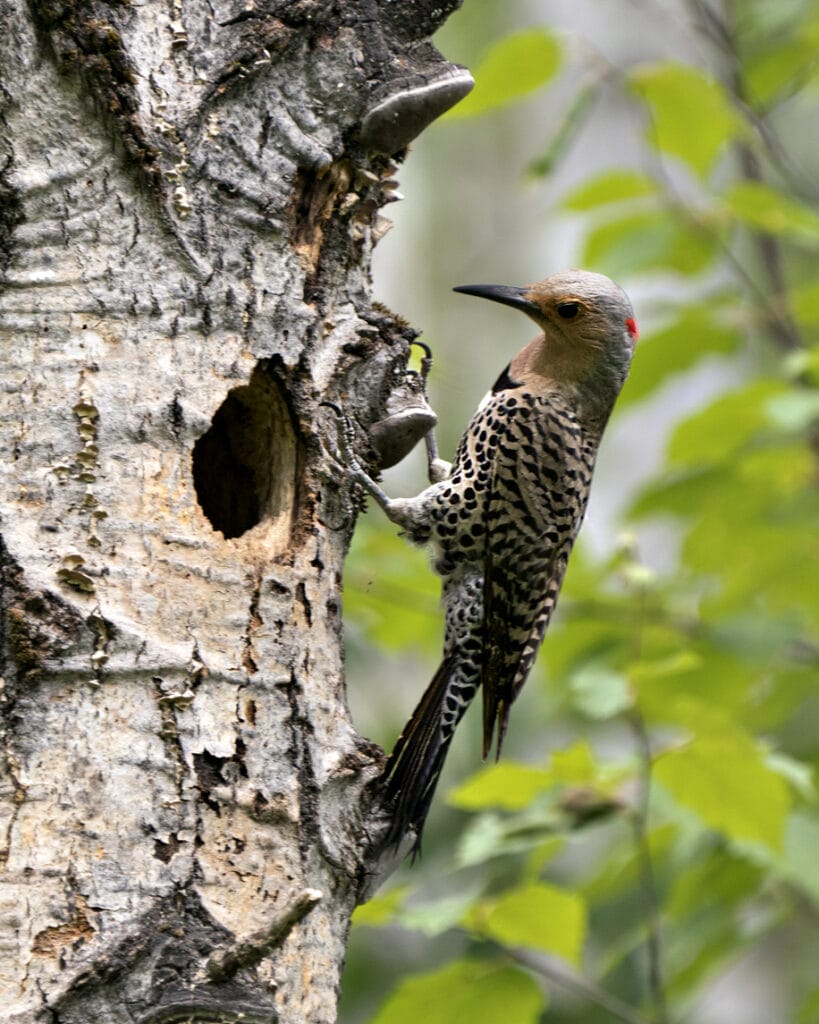
- Scientific name: Colaptes Auratus
- Length: 11.0-12.2 inches
- Weight: 3.9-5.6 ounces
- Wingspan: 16.5-20.1 inches
Northern Flickers are fairly large woodpeckers that are slightly smaller than the average crow. They can be found all year in Minnesota and are a common sight in woodlands, backyards, and parks.
Northern Flickers boast a gorgeous plumage with patterns of gray that are covered with black dots. There’s a red patch on the nape and another crest-like black patch on the chest. Males have a red patch on their cheeks which is replaced by a black patch on females.
Northern Flickers are ground foragers. They seek most of their food on the ground instead of looking for it on trees.
They still fly and look for food elsewhere but because of how common their ground foraging is, many people have accidentally scared Northern Flickers away from the ground by accident.
Author Note: Northern Flickers are among the fastest drummers out there, especially when they want to mate. A Northern Flicker would mix its calls with intense drumming (sometimes on metal) to attract a partner.
The partner usually pairs with the loudest drummer out there so the competition could get really loud. Northern Flickers have adapted to living in cities so if you have metal objects in your backyard, a competing Northern Flicker may scare you with some machine-gun drumming!
6. Red-headed Woodpecker

- Scientific name: Melanerpes Erythrocephalus
- Length: 7.5-9.1 inches
- Weight: 2.0-3.2 ounces
- Wingspan: 16.5 inches
Red-headed Woodpeckers are among the easiest woodpeckers to identify from a distance. Thanks to their gorgeous red crown that covers a “checkered body.”
That’s right! Because of the bold blue and white pattern of Red-headed Woodpeckers’ bodies, they are sometimes known as the flying checkerboards.
As if this wasn’t unique enough, Red-headed Woodpeckers have a loud, harsh-sounding call that could jumpscare you if you don’t see it coming. The initial loud call is sometimes followed by a few chirps that are much easier for the ear to handle.
If you live in Minnesota, you’d see the Red-headed Woodpeckers in the breeding season through spring to summer. In the southeastern part of the state, though, Red-headed Woodpeckers can be found any time of the year.
Red-headed Woodpecker juveniles don’t have blue feathers or red crowns. Instead, they’re replaced with dark brown feathers that slowly mature into adulthood colors.
Like most woodpeckers, Red-headed Woodpeckers are bark forages that spend most of their food-searching time on the tree barks. They are omnivores so they would eat fruits, seeds, insects, and sometimes eggs of other birds.
7. American Three-toed Woodpecker

- Scientific name: Picoides Dorsalis
- Length: 8.3-9.1 inches
- Weight: 1.6-2.4 ounces
- Wingspan: 14.6-15.3 inches
American Three-toed Woodpeckers are one of the rarest sights in Minnesota and the entirety of the United States.
Minnesota is actually one of the few states where the American Three-toed Woodpeckers could be spotted, and only in the northeastern parts of it.
American Three-toed Woodpeckers have earned that nickname for a reason. Most woodpeckers have four or zygodactyl toes. However, our three-toed buddies have only three.
The missing toe is one of the back toes. As a result, American Three-toed Woodpeckers can lean back a bit more than normal woodpeckers. That gives their drumming a bit more force than others.
The three-toed woodpeckers are aware of this. They use their high force to drill into tree barks where they feed on beetles and ants.
American Three-toed Woodpeckers have a fast call that consists of a single loud chirp. The juveniles, on the other hand, are a lot noisier. Their calls are non-stop chirps that go on and on until they’re fed.
8. Pileated Woodpecker

- Scientific name: Dryocopus Pileatus
- Length: 15.8-19.3 inches
- Weight: 8.8-12.3 ounces
- Wingspan: 26.0-29.5 inches
Pileated Woodpeckers are crow-sized birds that easily earned the title of our list’s biggest bird.
Top Tip: They can be found all year round in Minnesota, specifically in woodlands, forests, and backyards with feeders.
Pileated Woodpeckers generally have black plumage with some white stripes around the neck and crown area. Their most unique feature is the large crest on their heads. Males are often recognized by the presence of a red patch on their cheeks.
They’re not a rare sight but they’re also not the most common. Their numbers are declining because of the removal of eastern forests back in the 19th century.
Nevertheless, when Pileated Woodpeckers are around, they will let you know. Their calls are loud noises that sound like “wak wak wak wak.” The speed of their calls varies. The faster and louder they get, the more defensive the bird is.
A Few Extra Words
Woodpeckers in Minnesota have learned to live and co-exist with us humans, but that doesn’t mean they aren’t willing to get defensive.
If you happen to spot some woodpeckers in your backyard or any other place, it’s best to let them mind their own business.
You could go the extra mile and provide them with some food and water, but you shouldn’t attempt to catch or keep them. They are not to be domesticated.
FAQ
Have a look at these places:
Sax-Zim Bog, Lost River State Forest – Black-backed Woodpecker
Sherburne National Wildlife Refuge – Red-headed Woodpecker
Rice Lake National Wildlife Refuge – Yellow-bellied Sapsucker
The Downy Woodpecker and Northern Flicker are the woodpeckers most commonly seen in Minnesota.
To find out where recent sightings of woodpecker have been, try eBird. You can search for the latest sightings or particular species or what has been seen in a certain area.




